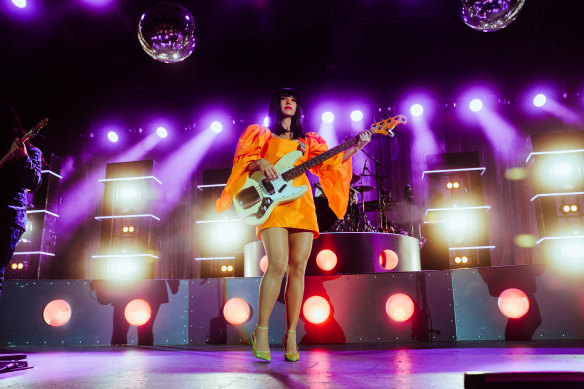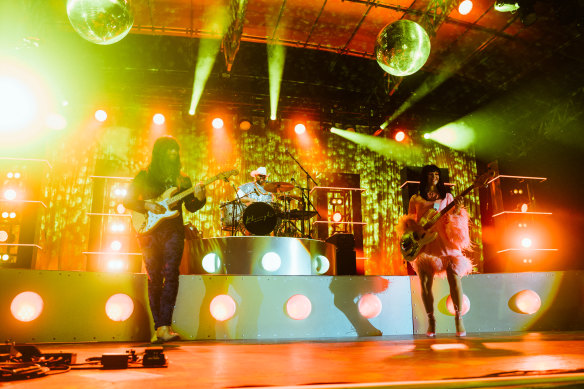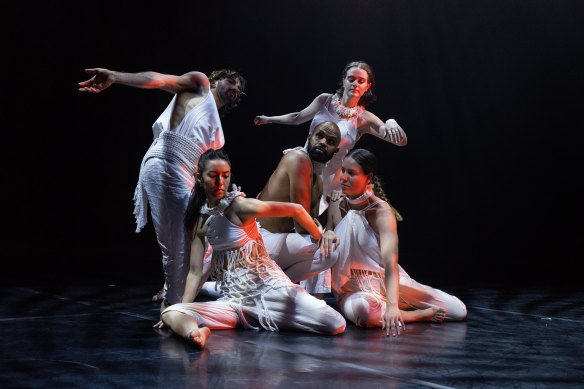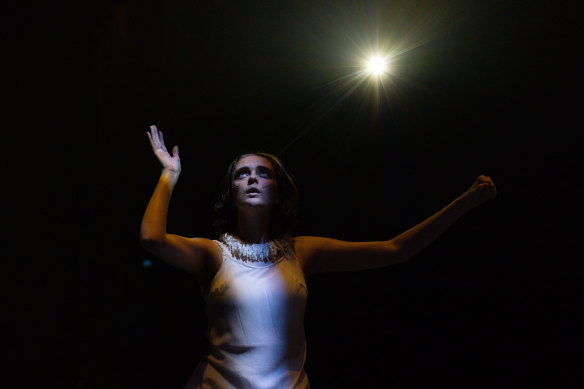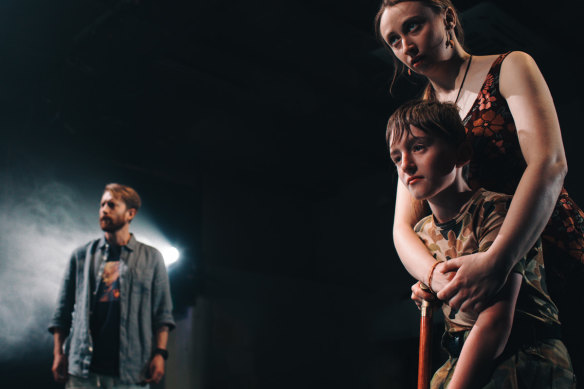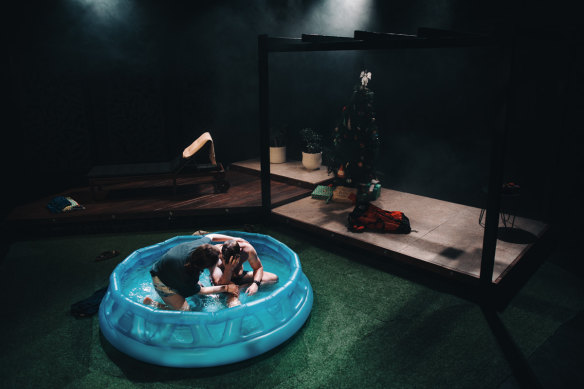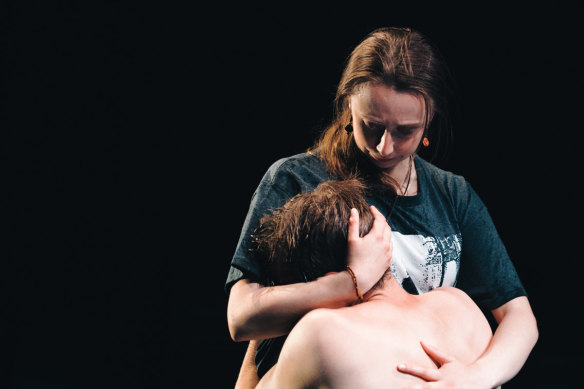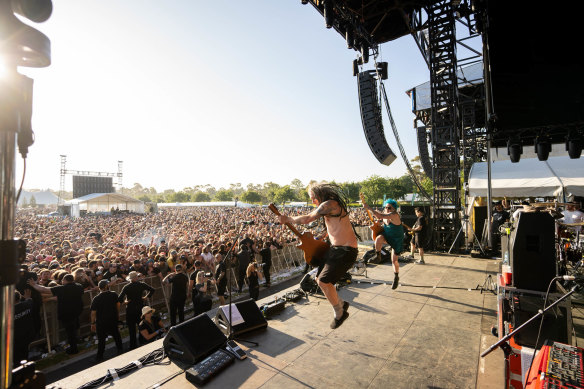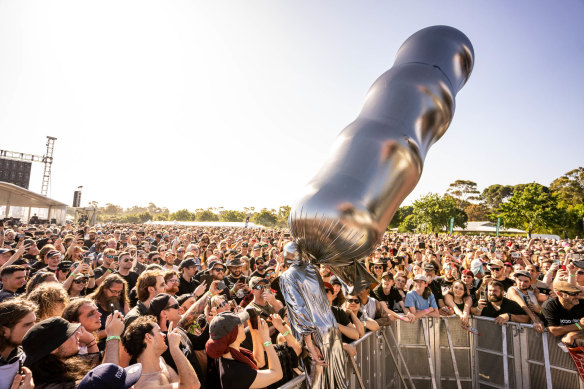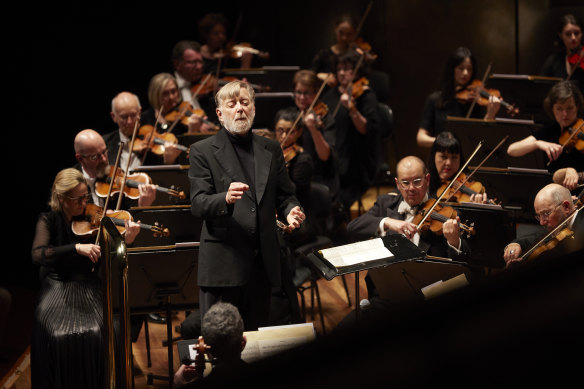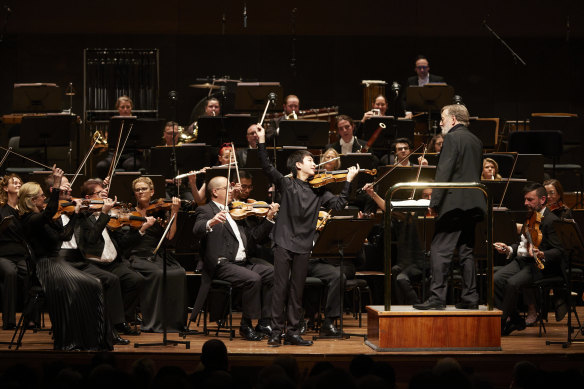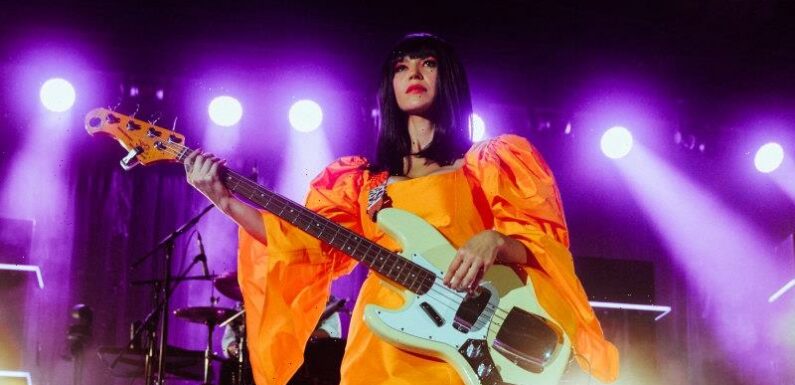
This wrap of shows around Melbourne includes Khruangbin at the Sidney Myer Music Bowl, a sprawling work of dance that brings together the aesthetic of a discotheque with a Wiradjuri creation story, and ambitious production of a theatre classic, a festival that had the crowd in raptures, and a memorably festive performance by the MSO.
MUSIC
Khruangbin ★★★★
Sidney Myer Music Bowl, December 3
Khruangbin is the Thai word for aeroplane – and it’s a fitting name for a band whose music shimmers with sounds and inspiration from around the world.
Khruangbin perform at the Sidney Myer Music Bowl on December 3, 2022Credit:Jackie Lee Young
Each member of the mostly-instrumental, Houston-based trio is compelling and elemental, and as such, they flourish as one unit. Opening the band’s two-night Melbourne jaunt were ARIA award winning local outfit Mildlife, and acclaimed LA saxophonist Kamasi Washington with his spectacular band. Unlike many lineups, there is no hierarchy to this one. The show functions more like a mini festival, with thousands of colourfully dressed, happy Melburnians implored to take in the whole spectacle while basking in the long-missed sunshine.
At dusk, Khruangbin unravels proceedings with moody, desert-tinged track Rules, from 2018 album Con Todo El Mondo. Drummer Donald “DJ” Johnson Jr is elevated on his own podium centre stage, a steady anchor both in presence and groove. Bassist Laura Lee and guitarist Mark Speer mirror the other on opposite points of the stage. They are both visions; glamorous and beguiling.
Khraungbin performing at the Sidney Myer Music Bowl – bassist Laura Lee and guitarist Mark Speer mirror the other on opposite points of the stage.Credit:Jackie Lee Young
Khruangbin’s performance strikes a mesmerising balance of stylised and instinctive; they move freely, but with gorgeous precision. The three weave between sultry, dark cowboy jams, to funky, infectious numbers that feature their joint, pithy vocals.
Fans rejoice at Lee’s self-assured, chanted “Yes” in Evan Finds The Third Room. After a mid-set outfit change, the band take a baffling but hilarious turn by digressing into medleys from greatest hit pop/rock songs.
Khruangbin’s power comes from their interpersonal energy, and this is challenging for most audience members to lock into, given their location all the way back on the Bowl’s lawn. Khruangbin are electrifying, soulful performers, and their music makes for a blissful session of dancing, but there is undoubtedly greater nuance to their performance that gets lost in a sprawling amphitheatre.
Reviewed by Jess Zanoni
DANCE
Garabari ★★★½
Joel Bray Dance, Arts House, North Melbourne, until December 10
Garabari, which is a Wiradjuri word for corroboree, is the latest and largest in a series of participatory works that draw on the Indigenous heritage of Joel Bray, a theatre-maker who works in Melbourne but comes from central New South Wales.
Scenes from Joel Bray’s Garabari.Credit:Asanka Ratnayake/Getty Images
Like its acclaimed predecessor, Considerable Sexual Licence, this sprawling dance-theatre-installation-shindig is an attempt to force new connections across time and space, people and myth, bringing together the aesthetic of a discotheque with a Wiradjuri creation story.
The work builds slowly. At first, the audience is free to wander the large hall. A chain of curtains creates a serpentine curve that symbolises the Murrumbidgee River and there are vibrant projections and bush sounds mingled with muted beats.
A scene from Garabari by Joel Bray and Chunky Move.Credit:Asanka Ratnayake/Getty Images
The dancers drift around the space: shifting the curtains, embracing audience members and performing fragments of slow-motion choreography. With their white robes and dreamy smiles, they look rather like members of a millennial spaceship cult.
And Garabari does aim at a kind of teleportation. The audience is eventually herded around a central performance space where the Girawu story of greedy goanna men and a brave goanna woman is narrated in a powerful dance featuring traditional motifs.
With the waters of the river liberated by the goanna woman and her digging stick, the audience is invited – not quite compelled – to join the revelry. There is a conga line and limbo and simple mass choreography. And then, of course, it finishes with a free-for-all.
Garabari is presented by Chunky Move, which is interesting because of its resemblance to the most recent work by Chunky Move artistic director Antony Hamilton: lavishly decorated immersive pieces that make a spectacle of the involvement of the audience.
Joel Bray, however, is on his own trajectory, with his own experimental Indigenous dramaturgy, shaped by a yearning for connection and a need to rewrite history and create new narratives.
Reviewed by Andrew Fuhrmann
THEATRE
Little Eyolf, by Henrik Ibsen ★★
Theatre Works Explosives Factory, until December 10
Before canvassing some significant problems with this production, let me state the obvious. An ambitious staging of Ibsen’s Little Eyolf deserves every encouragement. The cultural topsoil is thin in this country: engaging regularly and deeply with the canon of world drama is vital if we want thousands of years of tradition to exercise and enrich the creativity of Australian theatre-makers.
A scene from Little Eyolf at Theatre Works.Credit:Jack Dixon-Gunn
And yes, as we now routinely acknowledge, Indigenous performance and storytelling have an even longer history, but it would be naïve to imagine we can pay them due respect when most other aspects of our theatrical inheritance are neglected.
In nearly two decades as a critic, I’ve never seen Little Eyolf live – only the 1982 BBC version with Diana Rigg and Anthony Hopkins. This production from Heartstring Theatre attempts to redress that void. It’s a massive ask. The artists have an idea of what the play should be like, without the ability to raise their vision much above the level of a rehearsed reading.
Tragedy strikes the Allmers family in Little Eyolf. Credit:Jack Dixon-Gunn
The play’s grim undertow carries within it a cursed hoard of timeless themes – the cruelties of guilt and grief and possessive love, the scope of human responsibility, and the life-denying power of social roles (especially motherhood) among them.
Tragedy strikes the Allmers family when their only child Eyolf (Zac Steedman) drowns unsupervised in the sea. A visit from the Rat-Wife (Ioanna Gagani) foreshadows his doom with the eerie inevitability of a fairytale, but it’s clear the marriage between the rich, embittered Rita (Elisa Armstrong) and her philosopher husband Alfred (Damien Harrison) is already floundering.
Jealous of Alfred’s bond with his sister Asta (Liliana Dalton), Rita craves her husband’s undivided love and attention to the point of wishing that Eyolf had never been born. For her part, Asta is courted by the staid engineer Borgheim (Alexander Tomisich), whom she does not love, though she takes the least-worst option when her brother and his wife want her to stay on as a ghoulish proxy for their dead son.
A scene from Little Eyolf.Credit:Jack Dixon-Gunn
While the intimacy of the theatre design is impressive, the production doesn’t take advantage. Director Robert Johnson allows an unbelievably static performance style. I was reminded of Ken Tynan’s immortal backhander about John Gielgud – “the best actor [in the UK] from the neck up”. It’s as if the local beach had basilisks as well as a dangerous riptide. The actors stand frozen in place, which hamstrings their interactions and has the unfortunate effect (if you sit in the wrong seat) of obscuring crucial scenes.
The want of vocal modulation – especially Armstrong’s one-noted Rita, who starts with such heavy-duty resentment she has almost nowhere to go emotionally – doesn’t give the actors much to work with above the chin, either.
They don’t traduce Ibsen’s play – and I’m still glad I saw it – but many haunting subtleties are lost, from the murky suggestion of incest between brother and sister, to the possibility that the charitable ending – while falling short of cynical, Jeff Bezos-style faux-lanthropy – could be wishful thinking, a compulsive attempt by Rita to manipulate her husband into staying with her.
Reviewed by Cameron Woodhead
MUSIC
Good Things ★★★★
Flemington Racecourse, December 2
Just like they did at the final Big Day Out at Flemington Racecourse in 2014, Californian metal band Deftones had Friday’s massive crowd in raptures.
As the sun set on the main stage, Good Things festivities reached a deafening crescendo as Chino Moreno and his Deftones bandmates blasted through an hour of explosive rock.
Los Angeles band NOFX perform at Good Things in Melbourne. Credit:Tim Lambert
On the other side of the sprawling venue it was Regurgitator, dressed in matching yellow outfits, who added a bright local flavour to the day. It was familiar territory for the trio, originally from Brisbane, who again had the crowd singing along to Polyester Girl and other hits, like it was the 2008 Big Day Out all over again.
Parallels with the former BDO travelling festival have been warmly embraced by Good Things organisers, who welcomed 20,000 music fans back to Flemington for the first time since 2019. Blue skies, five stages, merchandise tents and more than 30 bands was precisely what festival-starved, live music fans had craved.
Early in the afternoon pub rockers Cosmic Psychos soaked up roars of approval from old and new fans, many who weren’t born when the band’s debut album was released in the late ’80s.
The crowd reacts to a performance by TISM at Good Things, December 2, 2022.Credit:Tim Lambert
Emerging at the same time as Cosmic Psychos, This Is Serious Mum was in long hibernation until this year. A handful of warm-up shows in recent weeks set the scene for TISM’s return, but nothing prepared the Good Things crowd for the band’s electro-fuelled pop and rock theatrics. Each adorned with a gigantic silver balloon that reached the height of the stage, the seven-member group unleashed a barrage of their best known songs, including I Drive a Truck, Martin Scorsese Is Really Quite a Jovial Fellow and Saturday Night Palsy.
Dressed to impress in blue and white striped overalls, You Am I’s Tim Rogers led his band of rock ’n’ roll brothers through a blistering set, while French band Gojira whipped up a heavy metal frenzy on the main stage.
Gojira drummer Mario Duplantier stood out like TISM’s silver outfits on a day when loud, heavy and fast were common themes. Duplantier’s ferocious drumming style, incorporating polyrhythmic patterns, sits at the heart of the band’s incredibly powerful sound.
British headliners Bring Me The Horizon were just as impressive with 36-year-old Oliver Sykes showing why he’s among modern rock’s most highly rated vocalists.
A smorgasbord of thunderous highlights included Italian gothic rockers Lacuna Coil, and the hugely popular, veteran punk rock band NOFX from Los Angeles, who dipped into a catalogue of 15 albums spanning more than three decades.
Norwegian punk outfit Blood Command won a swag of new fans with their first Australian performance, and the eclectic line-up benefited from the return of Swedish skate-punks Millencolin, an early set from Ukranian metalcore group Jinjer, German electronicore outfit Electric Callboy, and Melbourne group Kisschasy’s first festival performance in seven years.
Good Things was in Sydney on Saturday and Brisbane on Sunday, leaving behind sun-kissed Melbourne fans with new T-shirts and rock ‘n’ roll ringing in their ears.
Reviewed by Martin Boulton
MUSIC
Mendelssohn and Brahms ★★★★
Melbourne Symphony Orchestra, Hamer Hall, December 2
An invigorating mix of seasoned showmanship and emerging talent elevated what could have been a routine end-of-year Melbourne Symphony Orchestra concert to a memorably festive event.
Sir Andrew Davis conducts the MSO performance Mendelssohn and Brahms, December 2, 2022.Credit:Laura Manariti
Former chief conductor Sir Andrew Davis, making his first appearance as the orchestra’s conductor laureate, showed he has lost none of his customary energy and insight; opening proceedings with a zestful account of Carl Vine’s 1986 MicroSymphony. The orchestra’s ardent playing made clear that this colourful work, teeming with rhythmic, melodic, harmonic and textural ideas, provides as much interesting detail for players as it does for listeners.
Melbourne-born teenage violinist Christian Li brought dazzling technique and inexhaustible enthusiasm to Mendelssohn’s popular Violin Concerto in E minor.Credit:Laura Manariti
Melbourne-born teenage violinist Christian Li brought dazzling technique and inexhaustible enthusiasm to Mendelssohn’s popular Violin Concerto in E minor. In addition to his technical brilliance, Li projected a beautifully lustrous tone, due in no small measure to the superb 1737 ex-Paulsen Guarneri del Gesu violin he has the great good fortune to play.
Doubtless, Li will develop over time a deeper awareness of the vocal dimensions inherent in Mendelssohn’s genial tunefulness and enter into a more flexible and accommodating dialogue with his musical partners. Even so, it was heartening to see how this undeniably exciting performance engaged younger members of the audience.
From the opening violin sighs of Brahms’ Symphony No. 4, the living, breathing synergy between players and conductor gave the music a heady, romantic sensibility. In the first movement interchanges between strings and winds were seamlessly dovetailed. Splendid horn playing, particularly in the second and third movements, crowned a rich palette of instrumental colours. Davis helmed a masterfully paced performance, allowing the distinctly different nature of each movement fullness of expression.
At the end of this satisfying program, concertmaster Sophie Rowell received a deservedly warm ovation as she takes her leave of the MSO to become the new artistic director of the Melbourne Chamber Orchestra.
Reviewed by Tony Way
Sir Andrew Davis will be conducting the MSO in Sir Andrews Messiah at Hamer Hall on December 10 and 11.
A cultural guide to going out and loving your city. Sign up to our Culture Fix newsletter here.
Most Viewed in Culture
From our partners
Source: Read Full Article
